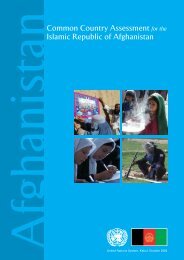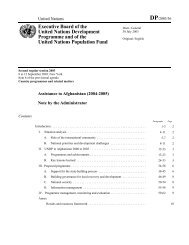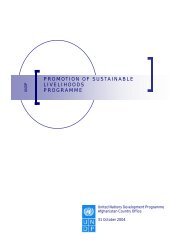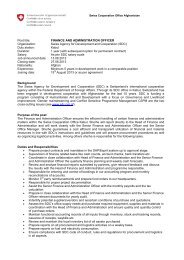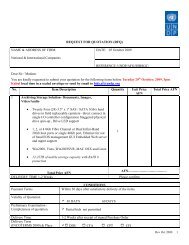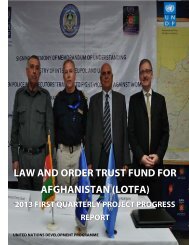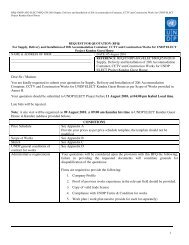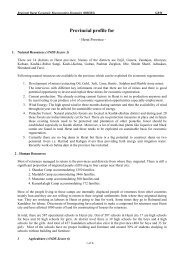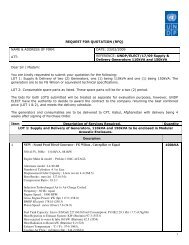Development Cooperation Report 2012 - UNDP Afghanistan
Development Cooperation Report 2012 - UNDP Afghanistan
Development Cooperation Report 2012 - UNDP Afghanistan
You also want an ePaper? Increase the reach of your titles
YUMPU automatically turns print PDFs into web optimized ePapers that Google loves.
2<br />
funding mechanisms such as the ARTF, LOTFA, AITF and others. A considerable amount<br />
of aid channeled through the trust fund mechanism (47%) was used to finance<br />
recurrent expenditures of the government. The US department of defense and LOTFA<br />
has been two of the largest sources of support to the operating budget, while ARTF’s<br />
support to government’s operating budget has slightly decreased during 2011.<br />
Government of <strong>Afghanistan</strong>’s efforts to prepare a realistic budget with medium term<br />
outlook was weakened by lack of predictable data on aid allocations. External assistance<br />
continued to finance close to 52% of the national budget. However, lack of timely<br />
information on annual donor commitments, even indicative, and actual disbursement<br />
data undermined the planning process. Available data shows that only USD 4.5 billion<br />
will be provided by donors to support development during 2013. This number is<br />
considerably lower than the level of aid provided during 2011 and inconsistent with<br />
the level of aid pledged at Chicago and Tokyo (i.e. USD 8 billion per year for the next<br />
four years).<br />
DEVELOPMENT COOPERATION REPORT<br />
The share of aid through the national budget allocated to development projects has<br />
declined in 2011. This is despite the fact that the share of aid channeled through the<br />
budget has experienced an increment of 17% over the year 2010. Out of USD 2.17<br />
billion provided through the FY1390 (2011) national budget, only USD 688 million was<br />
used to finance development projects. This is in part because 86% of the remaining<br />
USD 1.48 billion was allocated to cover security related expenditures.<br />
An important milestone for the international community, as it relates to aid<br />
effectiveness, was to deliver on their Kabul Conference commitments of channeling<br />
at least 50% of external aid through the budget and aligning 80% of their assistance<br />
with the national priorities within two years from July 20, 2010. In nominal terms<br />
the amount of aid through the budget has increased from USD 1.8 billion in 2010<br />
to USD 2.17 billion in 2011. Yet aid through the budget as a percentage of total aid<br />
disbursements remained at 18% for both years, a clear indication that progress on<br />
achieving the Kabul Conference targets have been lagging during 2011.<br />
In terms of achieving greater alignment of aid with national priorities, MoF is not<br />
in a position to present a clear picture of progress achieved through 2011. This is in<br />
part because the focus was invested in the preparation of National Priority Programs<br />
agreed to during the Kabul process. One measure that provides a good indication<br />
of donor’s progress in improving alignment of aid is the extent to which they have<br />
used the national budget system. As mentioned earlier, only 18% of aid was disbursed<br />
through the national budget during 2011. Another measure of alignment is the extent<br />
to which projects funded through external aid are consulted with line agencies and are



